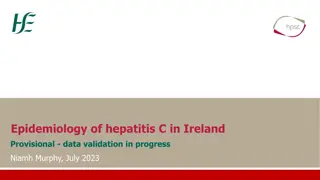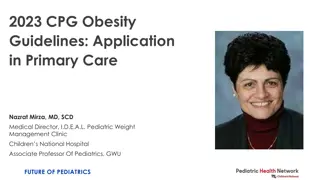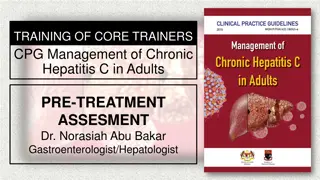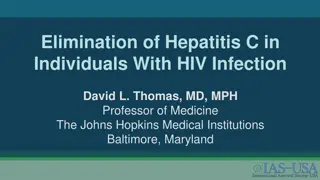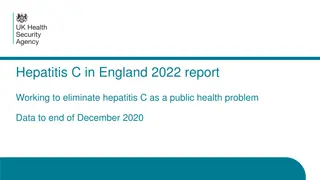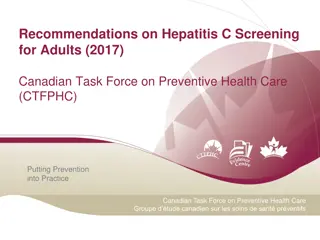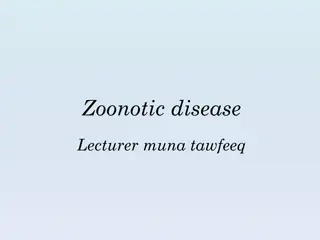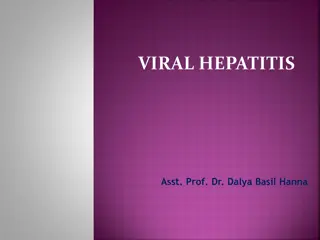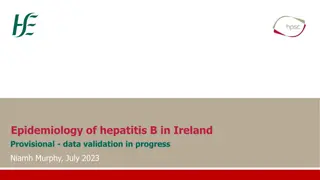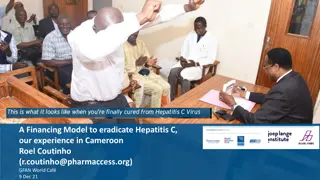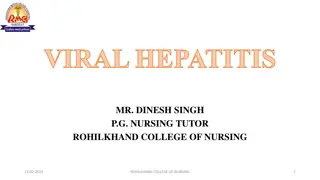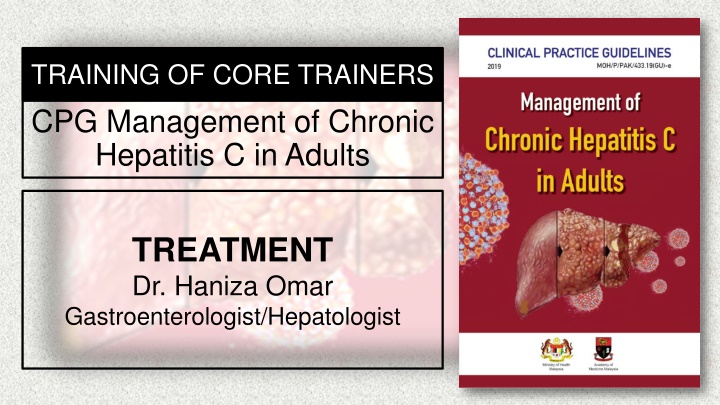
CPG Management of Chronic Hepatitis C in Adults: Training Overview
In this training session conducted by Dr. Haniza Omar, a Gastroenterologist/Hepatologist, core trainers learn about assessing pre-treatment conditions, cirrhosis identification, DAA treatment protocols, and non-pharmacological support for HCV-infected patients. The session emphasizes achieving SVR to prevent complications and improve patient outcomes.
Download Presentation

Please find below an Image/Link to download the presentation.
The content on the website is provided AS IS for your information and personal use only. It may not be sold, licensed, or shared on other websites without obtaining consent from the author. If you encounter any issues during the download, it is possible that the publisher has removed the file from their server.
You are allowed to download the files provided on this website for personal or commercial use, subject to the condition that they are used lawfully. All files are the property of their respective owners.
The content on the website is provided AS IS for your information and personal use only. It may not be sold, licensed, or shared on other websites without obtaining consent from the author.
E N D
Presentation Transcript
TRAINING OF CORE TRAINERS CPG Management of Chronic Hepatitis C in Adults TREATMENT Dr. Haniza Omar Gastroenterologist/Hepatologist
Learning Objectives 1. Assessing pre treatment assessment 2. Determining compensated & decompensated cirrhosis 3. Looking for drug-drug interaction (DDI) prior to initiating treatment with direct acting antiviral 4. Availability of types of direct acting antiviral (DAA) 5. Duration of treatment in different combinations of antiviral for different genotypes in treatment na ve & experience. 2
Goals of HCV Treatment Primary Goal Secondary Goal Slow disease progression Eradicate HCV infection by achieving Virologic Cure (SVR) Improve histology Prevent complications from HCV infection Reduce risk of HCC Improve health-related QOL The goal of treatment: reduce all-cause mortality & liver-related health adverse consequences, including end-stage liver disease & hepatocellular carcinoma, by the achievement of virologic cure as evidenced by an SVR Source: 1. Ghany MG et al. Hepatol 2009;49 (4):1335-74. 2. Lindsay K et al. Hepatol 2002;36 (5, Suppl 1):S114-20.
Non-pharmacological Treatment HCV-infected patients should be counselled on the importance of strict adherence to attain high sustained virological response (SVR). It is a multidisciplinary approach involving dedicated clinicians, pharmacists & nurses; it includes: o HCV education o monitoring services o peer-based support 4
Non-pharmacological Treatment -2 The following group will need additional support during DAA treatment 14. 27. European Association for the Study of the Liver. J Hepatol. 2018;69(2):461-511. Dieperink E et al. Addiction. 2014;109(11):1869-77 5
Pre-treatment Assessment Prior to initiation of treatment, hepatitis C must be assessed to identify presence of co morbidity and to determine cirrhosis status. The following investigations need to be performed: o full blood count (FBC) o liver function test (LFT) o serum creatinine o international normalisation ration (INR) o HIV & HBsAg screening 7
Pre-treatment Assessment -2 For decompensated cirrhosis using CPS score . those with cirrhosis, assessment for compensated & 8
Drug-drug Interactions (DDIs) Pre-treatment assessment of concomitant medication should be done to avoid DDI Prescribers may consult the University of Liverpool webpage on hepatitis drug interactions at https://www.hep-druginteractions.org/checker 10
Direct-acting antivirals (DAAs) Treatment for chronic hepatitis C has evolved from using pegylated-interferon (PEG-IFN) with low cure rates and many side effects to various regimes of oral DAAs. The aim is to provide high cure rate or SVR by using drugs that are effective with short duration treatment and minimal side effects. 11
Direct-acting antivirals (DAAs) -2 Hepatitis C patients (confirmed viraemia) should be considered for DAA treatment except in those with limited life expectancy or significant non-liver-related co-morbidities. Treatment should be initiated without delay in those with significant fibrosis or cirrhosis, decompensated cirrhosis & clinically significant extra-hepatic manifestations due to HCV infection.14 including those with 12
Direct-acting antivirals (DAAs) -3 13
Sustained Virological Response (SVR) The endpoint of therapy is an SVR, defined by undetectable HCV RNA in serum or plasma 12 weeks (SVR12) or 24 weeks (SVR24) after the end of therapy, as assessed by a sensitive molecular method with a lower limit of detection 15 IU/ml 14
Pharmacological Treatment Duration (weeks) 15
Pharmacological Treatment -2 Duration (weeks) 16
Pharmacological Treatment -3 Decompensated Cirrhosis 17
Pharmacological Treatment -4 Liver Transplant Patients 18
Take Home Messages Treating patients with Hepatitis C has been made simple with the availability of the new oral DAAs. The aim of treatment is to achieve SVR. DDI should be assessed to avoid potential side effects. Duration of treatment are 12 weeks for non-cirrhotic & treatment-na ve group. Duration of treatment are 12 - 24 weeks in the cirrhotic group depending on genotypes & if the patient has been on treatment before. 19
THANK YOU THANK YOU


